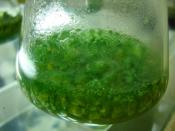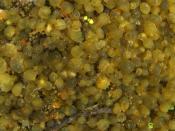Anneka Ahmad
Cyanobacteria (blue-green algae)
Algae are very simple chlorophyll-containing organisms. In general, simple organisms composed of one cell, or grouped together in colonies, or as organisms with many cells, sometimes collaborating together as simple tissues. Phytoplankton is a for of algae and it is known to provide food for fish, this phytoplankton grows in vast numbers in both fresh and marine waters. Algae is extremely important for releasing oxygen formed during the process of photosynthesis. In areas where there are a lot of brown algae, the plants are ground and used to fertilize the soil. Some algae are used in special foods and it is also produced commercially to provide a source of protein for both humans and domestic animals. The largest forms of algae are seaweeds that can be 100 m from the ocean bottom to the water's surface. Although most algae grow in fresh water or seawater, they also grow on soil, trees, and animals, and even under or inside porous rocks, such as sandstone and limestone.
Algae tolerate a wide range of temperatures and weather conditions such as; in hot springs, on snow banks, or deep inside polar ice.
Water that is polluted with organic matter or sewage provides an ideal environment for the growth of many algae and as a result of this blooms are formed, these blooms are a good indication of water pollution. These blooms can occur when the algae die and decompose, depleting the dissolved oxygen in the water. There are many different types of algae and one type of algae is blue-green algae, cyanobacteria,
Cyanobacteria are a much simpler type of cell, compared with the eukaryotic cells which are typical to the majority of species, as it lacks organelles. This type of cell is considered to be a prokaryotic cell. Prokaryote...


